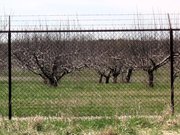Fence
|
|
- This article is about the structure. For other meanings, see Fence (disambiguation).
A fence is a freestanding structure designed to restrict or prevent movement across a boundary. It is generally distinguished from a wall by the solidity of construction: a wall is usually restricted to such barriers made from solid brick or concrete, blocking vision as well as passage (though the definitions overlap somewhat).
Rrred.jpg
Fences are constructed for several purposes, including:
- Agricultural fencing, to keep livestock in or predators out
- Backyard fencing, to keep children or pets in or to provide privacy
- Security fencing, to prevent trespassing or thievery
- Decorative fencing, to enhance the appearance of a property or garden
8499720-R1-017-7SplitRail_wb.jpg
Some of the technologies developed for fencing include:
- Palisade
- Barbed wire
- Electric fencing
- Post-and-rail fencing
- Rock wall fencing
- Hedgerows of intertwined, living shrubs
- Split rail fencing, often laid in a zig-zag pattern, particularly in colonial United States
- Picket fences, generally a waist-high, painted, partially decorative fence
- Turf mounds in semiarid grasslands such as the western United States or Russian steppes
Alternatives for a fence are a hedge or a ditch (occasionally with water, that is, a moat).
A balustrade or railing is a kind of fence to prevent people from falling over the edge, for example, on a balcony, stairway (see railing system), roof, bridge, or elsewhere near a body of water, places where people stand or walk and the terrain goes steeply down, and so on.
Legal issues of dividing fences
Fences can be the source of bitter arguments between neighbours, and there are often special laws to deal with these problems. Common disagreements include what kind of fence is required, what kind of repairs are needed, and how to share the costs.
See also
References
- Encyclopedia Britannica (1982). Vol IV, Fence.da:Hegn

